The Man Bennett
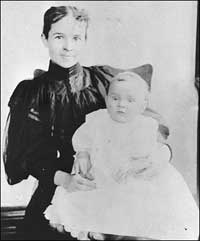 |
Clara Ford and Edsel Ford |
Initially, Bennett was hired as a bodyguard for Henry Ford, but he soon became involved in various matters concerning Ford. While this esteemed businessman could be difficult with many, he always made time to meet with Bennett, either in person or via telephone. It seems that due to his skillful handling, Bennett won Henry Ford’s affection, eventually claiming the title of Personnel Director. Ford appreciated Bennett as he maintained close contact with the gangsters in the company, which Ford believed was the best way to counteract disruptions caused by workers and potential usurpations by descendants.
Bennett often associated with criminals and hired killers. At a party hosted by Bennett at Ford Motor Company, the Governor of Michigan was shocked and dismayed to find a notorious murderer present, someone sought by the police. Later, Bennett recounted this incident in his autobiography: “Since the Governor was known for being pompous, I felt delighted to see him flustered.”
Bennett always carried a pistol with him. One day, he shot the lit end off a person’s cigarette, violating Henry Ford’s strict ban on smoking in the factory. He devised various tests to challenge the loyalty and discretion of company employees. On one occasion, with an air of secrecy and importance, Bennett handed an employee an envelope, instructing: “Keep this until I ask for it. Remember, don’t tell anyone I gave it to you.” A few days later, the employee’s direct supervisor approached him, saying: “Mr. Ford asked me to retrieve the documents you’ve been keeping.” If the employee honestly returned the envelope, he would be fired by the weekend. Conversely, if he swore he had kept no documents, he would receive a pay raise and promotion. Through this method, Harry Bennett tested the absolute loyalty of the employees.
Henry Ford II
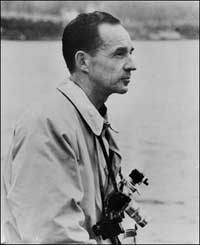 |
Edsel Ford – 1939 |
In 1943, Edsel Ford passed away from cancer. Henry Ford returned as the CEO of the company, but at 80 years old and in poor health, he could not devote much attention to the business. Bennett believed the time was ripe, as Edsel’s two sons, Henry II and Benson, were both enlisted in the military—one serving in the Navy and the other in the Air Force. Prior to World War II, Henry II and Benson had both interned at Ford Motor Company and shared their father’s disdain for Bennett. Henry II frequently argued with Bennett, while Benson refused to attend Board meetings in Bennett’s presence.
After Edsel’s death, Henry II was discharged from the military and returned to represent the Ford family at the River Rouge and Willow Run plants, where bombers were manufactured. This return deeply concerned Bennett. He endeavored to ensure that the young man did not attain any significant positions within the company.
At this time, Henry II felt very alone and lacked guidance, but he diligently sought to understand all matters by gathering information. Employees were hesitant to speak with him due to Bennett’s oversight. Meanwhile, Henry II patiently dug into every issue, including sales, which others neglected.
Henry Ford II’s first act was to invite Jack Davis, one of the founders who was living in seclusion in California, back as the Commercial Director in Dearborn. Davis was a close friend of Edsel’s but had been discredited by Bennett before the war. At that time, Edsel had to hide Davis by sending him to work at the California branch. Now, Henry II had an experienced and trustworthy advisor beside him, which was crucial for the young businessman to confront Bennett’s faction and navigate the overly complex organization of the company. Additionally, Bennett had John Bugas, the former head of the FBI in Detroit, on his side.
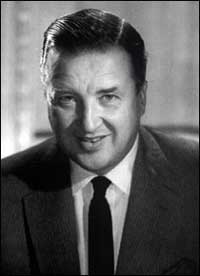 |
Henry Ford II |
As for Bennett, he was utterly ignorant, lacking knowledge in both manufacturing and commerce, so how could he manage such a complex and costly business? Bennett often skillfully declined Henry II’s suggestions, and when faced with critical decisions, he would be absent momentarily, only to return with messages from the office such as: “I just spoke with old man Ford. He opposes this.” In response to Bennett’s actions, Henry II frequently had to call Fair Lane to confirm, and in 9 out of 10 instances, the Ford family would reply that Bennett had not been there that day.
The management of the company faced such turmoil, yet no one in the family dared to inform the elder Henry Ford of the situation. Officially, Henry Ford I remained the CEO, and all major decisions required the approval of this prominent businessman. In this predicament, Davis and Bugas could only advise Henry II to be patient and wait…
One morning, Henry II learned that Bennett had made a codicil to the will of Henry I, of which the Ford family was unaware. According to this codicil, upon the death of the prominent entrepreneur, Ford Motor Company would be under the control of a Board of Directors led by Bennett for ten years. This news infuriated Henry II. Bugas confronted Bennett, informing him that Henry II was very upset and was seeking to alter certain terms in the will, to which Bennett responded: “If that’s all it takes to upset him, then tomorrow you come back to my office, and we’ll sort it out.” The next day, in Bennett’s office, Bugas was shown nine codicils along with the carbon copies, which Bennett then set ablaze, collecting the ashes into an envelope to give to Bugas for Henry II.
In light of Bennett’s actions, the Ford family realized that the only way to counter him was to swiftly make Henry II the CEO of the Company, despite the potential emotional impact on the elderly Henry I. Clara Ford took on this task. Henry I was often stubborn and irritable, but he generally listened to his wife.
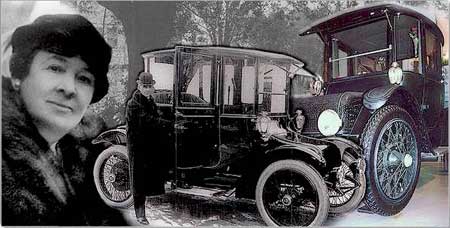
As soon as he learned of his grandfather’s intention to hand over the position, Henry II gathered with Davis, Bugas, and Mead Briker, one of the directors, to strategize before approaching his grandfather. Henry II stipulated that he would only accept the position if he had full authority to make changes within the company. He announced that he would convene the Board of Directors the following day. While waiting for his grandfather’s decision, Henry II received a call from Bennett. With a friendly tone, Bennett informed him that he had advised the businessman to appoint Henry II as CEO.
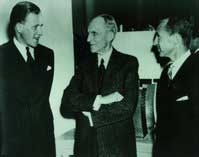 |
Henry II – Henry – Edsel Ford |
The next day, after a meeting, Henry II met privately with Bennett and informed him that Ford Motor Company would undergo a complete restructuring and that John Bugas would replace him as Commercial Director. Bennett was also informed that he could remain with the company if he wished. The following day, Bennett’s office was found engulfed in smoke; he had burned all his documents and vanished. Nonetheless, Henry II kept Bennett’s name on the payroll for 16 months so that he could collect his pension.
Assuming the role of CEO at the young age of 28 to compete with thriving companies like General Motors and Chrysler, Henry II was inexperienced and had no knowledge of business. However, he was guided by two highly capable women, his mother and grandmother. With their support, Henry II injected $4 million into the business. When asked why he took such action, the young CEO replied: “It was out of pride for our legacy!”.
Henry Ford II Reforms the Company Structure Henry Ford II undertook significant reorganizations within the company. Skilled workers were given the opportunity to attend training courses to ascend to higher positions. Henry II made daily operations at the factory more manageable and pleasant, demonstrating that close and friendly communication between management and workers is essential for enhancing productivity, which in turn increases profits. It is likely that Edsel deeply instilled a sense of social responsibility in his children, a concept that Henry Ford I deemed unnecessary.
Under Henry II’s Skillful Leadership, Ford Motor Company Regained its Status This achievement is remarkably impressive in the history of modern industry. In 1946, Ford Motor Company was on the brink of failure. Just four years later, Ford Motor reported a profit of $265 million, and vehicle sales surpassed those of Chevrolet in 1955. Ford Motor transformed into a completely new and prosperous company. This success was attributed to the work ethic of office staff, factory workers, and management, all of which can be credited to Henry II.
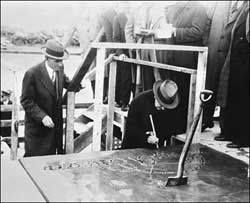 |
Henry Ford & Edison |
In addition to improving the company, Henry II also established the Ford Foundation, the largest philanthropic organization in the world, aimed at supporting useful initiatives in Education, Research, and Development.
On April 7, 1947, Henry Ford I Passed Away at the Age of 83. Henry Ford was indeed an outstanding figure in mechanics and commerce. His entrepreneurial spirit was particularly unique. It is even recounted that during a banquet for the King and Queen of the United Kingdom at the White House, President Franklin Roosevelt sent an invitation to Henry Ford, who wrote a letter of apology to the President for his absence, stating he could not attend because that day, Mrs. Clara was hosting a meeting for members of the Gardening Society.
Henry Ford authored four books in collaboration with writer Samuel Crowther, including: “My Life and Work” (1922), “Today and Tomorrow” (1926), “Edison As I Know Him” (1930), and “Moving Forward” (1931).
Henry Ford truly stands out as a significant figure in the History of the Automobile Industry.
—————————————
Return: “Henry Ford: The Father of the Automobile Industry“
Return: “Henry Ford: A Friend to Workers“
Return: “The Nature of Henry Ford“
Return: “The Model T was Replaced by the Model A“



















































